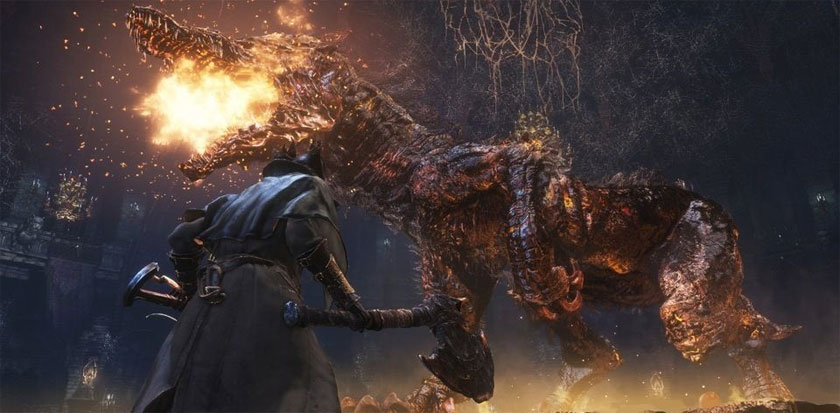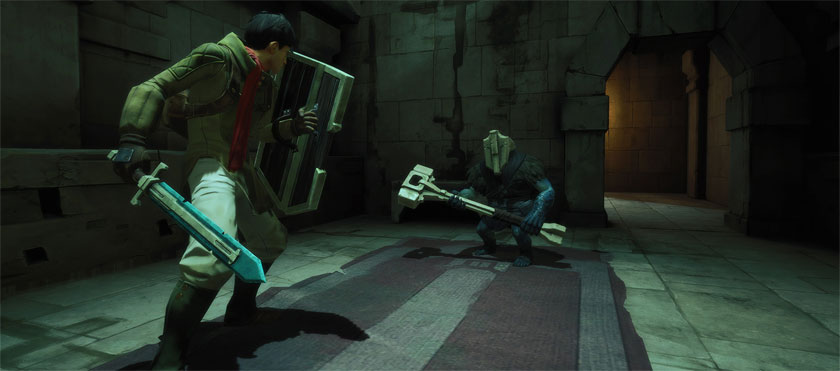Salt, Ash, and Souls

Last year I pompously declared Bloodborne an action-horror, abandoning the silly trend of defining a game’s genre by a very rigid set of mechanics. Today, I’m going to be a hypocrite and stick to the term “Souls-like” for both the sake of convenience, as well as to make a point regarding the rigid nature by which these genres are treated.
I’ve been playing Salt & Sanctuary of late. Streaming it, even. However, I’ve found that the frustration it fills me with makes for cranky commentary. I’ve continued to play it, but I’d rather my stream time be more pleasant and less griping and growling.
While the game may “prepare” me to better understand Dark Souls itself – much as Darksiders 3 helped better prepare me to enjoy and comprehend Bloodborne – it has also helped me appreciate the creativity of Gunfire Games and even From Software as they explored beyond the base mechanics of the progenitor game. Mechanically speaking, Salt & Sanctuary is Dark Souls (or Demon’s Souls) re-imagined as a side-scroller and little more. The greatest deviation is that there’s no “Humanity” component.
What a wasted opportunity.
Every so often Salt & Sanctuary reminds me of Ska Studios’ debut game The Dishwasher: Dead Samurai, an intense side-scrolling character action game. What really defined Dishwasher for me was the combination of high-speed sword-slicing action with incredible mobility and excruciatingly brutal executions and grabs. There’s a small trace of that here in Salt & Sanctuary, particularly the ability to execute foes that have been knocked off balance. There’s something satisfying about how the camera zooms in, your protagonist shoving a blade through their vulnerable foe and watching the blood splatter and the ground quake. It’s a visual feast…
...so long as you don’t get whacked in the head by a nearby opponent before you yourself can recover.
Whereas The Dishwasher feels like an inventive fusion of character-action and side-scrolling brawler with its own unique flair, Salt & Sanctuary feels as if it adheres way too strongly to its source inspiration in such moments. Perhaps even imitating incorrectly, as visceral attacks and back stabs in From Software’s games have longer periods of invincibility than they do in Salt & Sanctuary. This means there is even less incentive to go for the throat in the imitation than the original.
It leaves me to wonder what could have been if Salt & Sanctuary had tried to use Dark Souls as inspiration to transform what The Dishwasher does best. Perhaps reduce the mobility and focus on more defensive, guarded gameplay, but prioritize grabs and executions in ways that From Software has not done so. Ska Studios could have even beaten DOOM to the punch in 2016 by allowing executions to restore a portion of health, thus encouraging players to take similar risks with parrying and knocking back foes as they might with ripostes and rally in Bloodborne.

Actually, I feel as if Bloodborne should be a model for how developers ought to be for experimenting with the idea of the Souls-like rather than wholly sticking to the original design choices. I had asked last year if respawning foes at meditation zones made sense for Star Wars: Jedi: Fallen Order, a game where protagonist Cal was regularly in awe of the environment and powerful enough to pull opponents directly onto his lightsaber. Not only was Jedi: Fallen Order far less oppressive a setting, it made no sense for Storm Troopers to respawn and repeat the same battles and patrols just because a Jedi chose to meditate for a while.
I could ask a similar question of Darksiders 3. Like Jedi: Fallen Order, there’s no logical in-universe explanation for enemies to return to the game world. However, it was only upon death that said foes would respawn. Should the player choose to level up or teleport at one of the many locations of skeletal merchant Vulgrim, the enemies would still remain dead. For a game that emphasizes the “Metroid” in Metroidvania, this is actually a smart decision as it allows players to backtrack and explore territories without having to deal with enemies all over again. Contrast this with Jedi: Fallen Order, where you’ll stumble upon the same Storm Trooper patrol being attacked by the local wildlife for twelve times just because you decided to gain a level or two. Darksiders 3 pulls in elements of Dark Souls to influence its design, but only enough to work with that particular game’s vision. Jedi: Fallen Order only has enemies respawn at rest areas because that’s how Dark Souls did it.
To bring us back on track, we can similarly observe how From Software had taken away one of the crucial elements of Dark Souls when designing Bloodborne’s combat. Rather than keep the shield and its importance in blocking and parrying, attention instead went to the dodge. The player is far more nimble in the Victorian nightmare world than in the tormented lands of fantasy. They also do not struggle to stand back up after a roll, immediately finding themselves upright and ready to move. The player’s off-hand has thus been freed up for a gun, used to shoot a foe to knock them off-guard in the middle of an attack rather than awaiting the moment the blow lands to knock them aside. Enemies deal far more damage on average than in Dark Souls, but the player can regain some health should they counter-attack swiftly enough after being wounded. Or, perhaps, they can equip a rune that restores health during a visceral strike – a critical blow dealt while the enemy is stunned. Rather than rely on the limited number of Estus flasks, the player has the more plentiful blood vials, frequently dropped by the enemies they slay.
Whereas Dark Souls is a slower pace of combat, focused on knowing when to block, when to dodge, and when to lower your shield to restore fatigue, Bloodborne is instead a more fast-paced game that focuses on quick evasion and aggressive strikes. It’s a “subtle” difference, to be sure, but Bloodborne is satisfying in its own way that Dark Souls is not.
Darksiders 3, of course, takes this further by designing its combat to be far more character-action oriented. Dodging an enemy’s blow not only avoids damage, but proper timing creates a window for a powerful arcana-infused counter-attack. It is often more beneficial to wait for the enemy to strike than to charge in head-first, much like it is more advantageous in Bayonetta to wait for your opponent to lunge so that you can activate Witch Time and slow your surroundings. While Darksiders 3 certainly takes cues from the Souls-like games that preceded it, it also grabs and pulls from a variety of other games and genres in order to create its own unique experience.
Of course, this comes as no surprise to me now that I’ve played Chronos: Before the Ashes. While Gunfire Games’ title could originally be simplified as little more than “Dark Souls, but in VR”, it is now widely available across multiple traditional platforms. If I were to be redundant, I would describe it as Dark Souls, but easier.

That greater ease is part of the reason I enjoyed it so much, however. Rather than focus on some currency that could be lost upon death – be it souls, blood echoes, or salt – the player gains experience and levels up in a traditional manner. Every time the player levels up, they restore all their health.
This created a new manner in which I engaged with the mechanics, separate from any other Souls-like I played. While the game had sanctuary locations that would respawn enemies, it would not restore the healing Dragon Hearts – the Estus Flask equivalent. Those would only restore upon death. As such, healing would become a gamble. Do I use one of my precious Dragon Hearts to restore my health, or risk another battle or two to level-up and heal then?
Of course, dying itself comes with advantages and disadvantages, so much so that it might behoove a player to intentionally die a dozen times early in the game so that they might obtain the boons of adulthood. On the other hand, the player may also find themselves dying frequently in the later stages of the game, which would start to change what benefits they obtain while introducing some detriments. The player may not immediately lose something as valuable as souls or echoes, but they move closer towards old age and therefore further from the benefits of youth.
While Chronos: Before the Ashes far more closely resembles Dark Souls than Darksiders 3 does, it also demonstrates how willing Gunfire Games is to take someone else’s established mechanics and experiment. To refer to these games as “Clones” is to diminish the creativity and careful consideration of what each change means.
To that end, Salt & Sanctuary is disappointing due to how rigidly it sticks to the mechanics of Dark Souls. Not to say it doesn’t have its own moments of creativity or influence from other genres. I’ve recently stumbled upon rotating platforms reminiscent of the Reznor wheel from Super Mario World, or the disappearing and reappearing platforms of classic Mega Man games. There’s also something to be said about maintaining the spirit of Dark Souls despite having only two-dimensions to work with. Yet that change from three-dimensional game to side-scroller is partially why I feel there ought to have been more consideration in how the experience was developed.
Salt & Sanctuary is a fine, if not frustrating, game. As always, it is impressive to see what just one man can do when creating his own video game. It’s just disappointing to see so much imitation here when my first introduction to Ska Studios was the unique and impressive The Dishwasher: Dead Samurai. Salt & Sanctuary will instead be remembered by me as a literal Souls-like, as opposed to the more creative takes in Darksiders 3, Chronos: Before the Ashes, or, heck, even Code: Vein and Jedi: Fallen Order.


